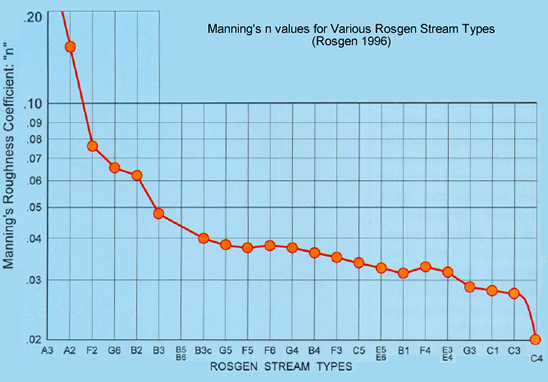
| glossary | menu | Normal | lg | hc | 9.) Fluvial Geomorphological Applications in River Forecasting > FGM and Flood Velocity Parameters |
| < Previous | 1 | 2 | 3 | 4 | 5 | 6 | 7 | 8 | 9 | 10 | 11 | 12 | 13 | 14 | 15 | Next > |
FGM and Flood Velocity Parameters

Channel type classification has utility in headwater hydrology and single discharge estimates. The Manning equation is one method of estimating river discharge and velocity, given field surveyed values for cross sectional area, wetted perimeter, and water surface slope. Manning roughness values, as explained in an earlier FGM Module Section, are required for such computations. While roughness values in Manning's equation for channel discharge are available from a variety of sources, several studies have demonstrated that channel type makes a good initial predictor of roughness value. Indeed, many look up tables simply use photos or descriptions of a Stream to generate an initial guess for the Manning n value.
In this image, Manning roughness n values are given for a variety of channel types. Boulder and cobble dominated A channels in the headwater areas have relatively high roughness values, which cause flow to slow. As is commonly known, information on vegetation improves estimates of roughness, and Rosgen has provided such graphical displays in other field notebooks. Of course, the best method to get a roughness value is to use USGS gauge data and survey in the waters surface slope and hydraulic radius, enabling a direct solution for the roughness coefficient and a better appreciation for the geomorphology of the channel.
Image courtesy of Rosgen
| < Previous | 1 | 2 | 3 | 4 | 5 | 6 | 7 | 8 | 9 | 10 | 11 | 12 | 13 | 14 | 15 | Next > |